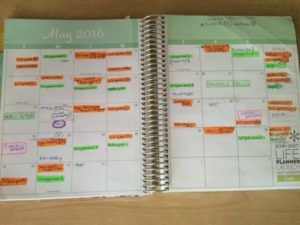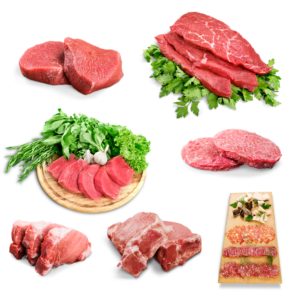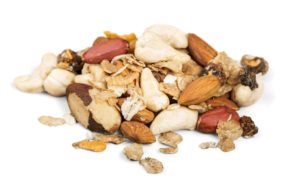For the past 38 days, I have been tracking my calories and my macros (the number of grams of carbs, proteins, fats I am consuming daily) on MyFitnessPal. While I do go through phases of keeping a food journal to keep my diet in check (jotting down what I ate, not including measurements), I have not counted calories in probably seven years. I usually eat very healthy: building my plate around protein and veggies, with a good (sometimes, generous) amount of fat. Thus, saving starchy carbohydrates for the evening if I was craving it (for the serotonin response to aid in sleeping), or forgoing it.
This is also the first time I am quantifying my macros. And you know what? I am actually enjoying it. Maybe it’s because I’m a recovering accountant, and I love to document and track everything — I have kept an agenda since grade 9, organizing and documenting my life. I still track all of my workouts the same way as I used to in high school and university in my paper agenda: recording them, highlighting anaerobic activities (weight lifting, hill sprints, metabolic conditioning workouts) in orange, and restorative activities (long walks, yoga) in green.

I sometimes even record the number of hours of sleep, days I have meditated and the number of alcoholic drinks I have had in a week — I relish in recording data and use it to analyze and reflect on how said activities affect my mind, body and spirit. So tracking my calories and macros just seemed like the natural thing to do.
What’s the difference between counting calories and tracking your macros?
They are similar in terms of keeping track of your energy intake – they are both based on calories. But one trumps the other. Simply counting calories does not take into account for the kinds of calories you are ingesting. Tracking your macros, on the other hand, holds you accountable to eating the right kinds of calories (in the proper amounts) and is based on your daily caloric intake goal. Thus, the former covers your caloric intake, while the latter covers the quality of calories in addition to tracking your overall caloric intake.
You can count calories and completely ignore the macronutrient composition of your diet, which might result in weight loss (if you are in a caloric deficit), but you might be losing muscle, not fat. Alas, although the scale number might go down, you are likely to look “soft” and not tight and toned. Why? Because along with the types exercise you are exposing your body to, the quality of your calories also affects your body composition.
For instance, you can eat a 1500-calorie diet consisting of cookies and ice cream and lose weight if that puts your body in a caloric deficit, but you’re more likely to be losing muscle, not fat. Whereas, a 1500-calorie diet consisting of complex carbs, high quality protein, nuts and seeds will result in fat loss, while preserving muscle mass. And generally speaking, people who are putting themselves in caloric deficit are desiring fat loss, not muscle loss (we need to preserve that, so our bodies become fat-burning, strong machines).
Whereas, tracking your macros encourages you to get the adequate amounts of protein needed for muscle repair and preservation, the proper amount of carbs for high exercise performance and enough fat for proper brain and cellular function and proper hormone regulation (which is important for fat loss).
Why Am I Tracking My Calories and My Macros?
- I wanted to be held accountable and have a tighter diet
- “What gets measured gets managed” – Peter Drucker. I wanted an honest look at my diet. I eat very healthy, but I do eat big portions. Tracking my diet (or anything, in general) is powerful and helps me create awareness as to why I eat what I eat
- Summer is basically here, and I want to get leaner
- Most of us underestimate what we eat, myself included
- It’s a reality check for emotional eating or eating just because it’s time to eat; studies have shown if you have to record your meals, you are less likely to eat junk food because of not wanting to record it
Lessons Learned So Far
- As of right now, I am enjoying it and it is motivating; I think it is a mix of the novelty of it or seeing it as some kind of a game. So I’m going to keep doing it, as long as it is serving me in a positive way; thus, not creating any neurotic behaviours or guilt-inducing feelings.
- I eat a lot of calories – I remember having a moment on the second day of tracking at 4pm thinking, “What! I’ve capped out on my calories for the day.” So from there, I learned to better manage my calories, and really tune into my body’s hunger cues.
- It’s stopped mindless eating and decreased my emotional eating
- It is actually very challenging to get the desired 40/30/30 protein/fat/carb ratios
Is this a Long-term Eating Approach?
It can be — it depends on the individual. For me, personally, probably not. Once I hit my goal, I will probably easy off. I predict that I will eventually get bored and/or will become efficient at estimating my macros that I will not need to meticulously.
Should Everyone be Tracking Their Macros?
No, it is not necessary for everyone. This is simply one methodology that can help someone achieve their fat loss, muscle gain or weight maintenance goals. Certain personality types who have specific goals can benefit from this kind of eating approach, while others might be more successful with more relaxed eating guidelines.
Who Can Benefit from Tracking their Calories or Macros?
- If you’re a healthy eating veteran and want to tighten up your diet
- If you have a short-term fat loss deadline (e.g. wedding, vacation, photoshoot, etc.)
- If you’re lean and want to get shredded (getting shredded is hard; it has to be calculated unless you’re genetically gifted)
- If you have the desire and are curious of what your diet consists of, in terms of calories and macros
- If you have hit a fat loss plateau, dialling into your nutrition will be extremely helpful
- If you suspect you are not getting adequate amount protein/carbs/fat in your diet (if you track it, you will find out shortly)
Who is this Not For?
- If you simply don’t feel called to do it, and you dread the idea of logging your meals. There are so many other eating practices and protocols out there that work. Find one that works for you.
- If tracking is going to trigger neurotic, self-loathing, perfectionist behaviours. Not worth it.
- If you are new to healthy eating, this is not necessary. You will greatly benefit by simply swapping unhealthy, processed foods with clean, whole foods (fruits, vegetables, lean protein, nuts).
- If you want to be healthy, not shredded
- If you’re content with your current maintenance weight
Whether you are wanting to learn more about your macros and/or how to track them, here’s a quick overview:
“Macros” or macronutrients are the three types of substances that give us energy (calories) in our foods: carbohydrates, fats, and proteins.
Each macronutrient yields a particular amount of calories:
Carbohydrates yield 4 calories per gram
Protein yields 4 calories per gram
Fats yield 9 calories per gram
Each macronutrient also has a different thermic effect of food (TEF) cost. What’s that? Your body burns calories by breaking down your food, digesting, absorbing and transporting its nutrients to all the tissues in your body. The higher the TEF cost, the more calories your body burns just by eating it.
The TEF of each macronutrient are as follows:
Carbohydrates: 5-15%
Protein: 15-30%
Fat: 2-5%
Carbohydrates
Carbs are our body’s main source of fuel. When carbs are digested, they are broken down into glucose to be used as energy. Any excess of glucose is converted into glycogen and stored in the muscles and liver. Carbs are important for providing our cells and tissues with energy; allowing our muscles, brain, kidneys, intestines (hello fibre!) and nervous system to function properly.

Sources of Carbs
Grains, fruit, starchy vegetables, pasta, many processed foods you find on the store shelves.
Protein
Protein is made up of amino acids, which are essential in building and repairing our muscles and tissues. Protein is also needed for proper immune function, healthy and strong nails, making and supporting hormones, preserving muscles mass and can be used as an energy source if carbohydrate is not readily available in the body. Protein also has high satiation power, meaning that you will stay “full” longer, after eating a meal high in protein, compared to just eating a high carbohydrate meal.

Sources of Protein
Eggs, fish, meat, poultry, dairy products, protein powders.
Fat
There are three main types of fat: monounsaturated, polyunsaturated and saturated fat, and they are all essential to the proper functioning of the body. We need fat for energy, optimal vitamin absorption (vitamins A, D, E, K), proper brain function, healthy cell membranes and hormone regulation that aids in fat loss.

Sources of Fat
Meat, poultry, fish, some diary products, nuts, oils, etc.
How Do I Calculate my Macros?
There are many ways to do this; find a calculator online (Google is your friend), or you can can guesstimate and do your own calculations.
1) I use MyFitnessPal. Select your caloric intake goal, and click on the macros button and put in your desired macro percentages.
2) Or, you can calculate it yourself by using this method:
- Figure out your calorie maintenance requirement.
You can do this by multiplying your bodyweight in pounds by 11 to 14.
11 = if you are sedentary
12 = somewhat active (working out 2-3 days/week)
13 = very active (working out 3-4 days/week)
14= extremely active (5-6 days/week) - If you want to lose weight, eat 10-20% under your caloric maintenance requirement; if you want to gain mass, 20% more.
- Divide your caloric maintenance requirement into your macros. A common ratio is: 40/30/30 for protein/fats/carbs
For example, if your goal is to hit 1600 calories for the day.
Protein: 1600 * .4 = 640 calories
640 calories /4 calories per gram = 160g protein
Fat: 1600* .3 = 480 calories
480 calories/9 calories per gram = 53g fat
Carbs: 1600*.3 = 480 calories
480 calories/4 calories per gram = 120g carbs
Then you test it. You can experiment with your body; monitor your energy levels and your body composition progress, and tweak the calories/macros as needed. If you are still hungry, increase your calories by 5-10% and see how you feel, see how your performance in the gym is affected and how you body composition responds. On the other hand, if you are not losing weight, try decreasing your calories by 5%. Keep adjusting as needed. These are just guidelines, at the end of the day, listen to your body and feed it with nourishing food.



June 1, 2016 at 8:06 pm
Very informative! Thanks for sharing your knowledge and counting experience! I’ve been using myfitnesspal to track what I’ve been eating and I actually like it. I’m not really serious about staying under my calorie limit but it does make me more conscious about what I am putting in my body, plus it is not very time consuming at all and gives me something to do while I am commuting ☺. I think it is great and I personally feel good using it at the time being, but I agree with you that it isn’t right for everybody 😉.
June 14, 2016 at 8:23 am
I have been counting macros since last October. While a struggle at first I have mastered it now and love it. It’s taken my body to new levels of fit I never saw possible. I love it because I have a sweet tooth and this allows for that!
Great information!
Xo Faith
June 16, 2016 at 5:14 pm
Interesting read! Great info and very helpful … esp with Macros .
Documenting is a nice visual… I liked your highlighted calendar .
Good job!
September 4, 2016 at 11:07 pm
Thanks for your write-up. My spouse and i have usually seen that the majority of people are wanting to lose weight since they wish to show up slim as well as attractive. Having said that, they do not often realize that there are additional benefits for losing weight in addition. Doctors assert that fat people are afflicted with a variety of conditions that can be directly attributed to their particular excess weight. The good thing is that people who’re overweight plus suffering from various diseases are able to reduce the severity of the illnesses through losing weight. You are able to see a continuous but identifiable improvement with health if even a slight amount of weight-loss is attained.